When it comes to the manufacturing of cosmetic, home care, and lifestyle products, few materials offer the same versatility, health benefits, and sustainability that the coconut plant does. To businesses that want to connect with today’s generation of health-conscious and eco-conscious customers, coconut-based ingredients that are ethically sourced and manufactured provide some of the most viable options.
For one, if a business is based in a country like the Philippines, coconut ingredients are affordable and easy to source. For another, the incorporation of natural, sustainable, and cruelty-free coconut ingredients—as opposed to ingredients like palm oil and petroleum—may resonate with discerning customers and create loyal markets. Coconut-based products are also enjoying greater popularity in foreign markets, like those of European countries, and can therefore secure for local businesses the chance to earn from exports.
What manufacturing ingredients comprise the most in-demand coconut products, and what do they do? To answer that question, here’s a briefer on six sustainable ingredients that come from the coconut plant and their most popular commercial and industrial applications.

6 Most Common Coconut-Based Ingredients and Their Uses
Refined, Bleached, and Deodorized (RBD) Coconut Oil
One of the most in-demand industrial products that come from coconut is refined, bleached, and deodorized coconut oil or RBD coconut oil. This product is derived from copra or the dried coconut kernel. After extracting raw oil from the copra, an RBD coconut oil manufacturer then deodorizes the oil using a method like steaming and filters it to remove contaminants like microorganisms, fungi, and insect remains. The process also rids the raw oil of its original brown colour, yielding a clear, odourless, and neutral-tasting oil product that can be used for a variety of applications.
RBD coconut oil is widely used for cooking, food processing, and the manufacturing of beauty products like natural soaps. On its own, it is also ideal for stockpiling in large amounts due to its long shelf life.
Cocoglycerides
Cocoglycerides are mixtures of monoglycerides, diglycerides, and triglycerides that are drawn from coconut oil. They are primarily used as emollients or ingredients that smooth out or soften dry and rough skin. It’s also not uncommon for them to be used as thickening agents.
These compounds are most well-known for their applications in cosmetics, like skin care products. But some companies also use them in pharmaceutical products and as food additives, particularly to give edibles a good consistency.
Potassium Cocoate
Another coconut-derived compound that’s been seeing wider industrial use is potassium cocoate. This compound acts as a surfactant, or an ingredient that reduces surface tension in a liquid, improves its wetting and spreading ability, and attracts dirt so that it can easily be rinsed off the body.
Potassium cocoate is commonly incorporated into beauty and home care products like household cleaning products, dishwashing soap, and multipurpose cleaners to name a few. Oftentimes, it is responsible for adding more bubbles to the end product.
Cocomonoethanolamide (Cocamide MEA)
Cocomonoethanolamide, or cocamide MEA for short, is a compound that comes from the fatty acids of coconut oil and monoethanolamine. It is commonly used as a surfactant and as a foaming agent for beauty and bath products.
This compound is also an effective emulsifier or an ingredient that helps stabilize oil and water mixtures. As such, cocamide MEA is an ideal addition to cosmetic products like shaving cream.
Cocodiethanolamide (Cocamide DEA)
Cocodiethanolamide, also known as cocamide DEA, is a diethanolamine derived from a mixture of coconut oil and diethanolamine. Cocamide DEA’s distinguishing property is its viscosity, which stabilizes the foam.
Like cocamide MEA, it is also used as a foaming agent for bath products and as an emulsifying agent for cosmetic products. Some other examples of products that incorporate cocamide DEA are shampoos, conditioners, bubble bath liquids, hair dye products, and pet care products.
Cocamidopropyl Betaine (CAPB)
Cocamidopropyl betaine, or CAPB, is drawn from coconut oil and the diamine dimethylaminopropylamine (DMAPA). CAPB is used as a medium-strength surfactant for bath products like soaps, hair care products like conditioners, and cosmetic products like a makeup remover.
CAPB is known for its excellent lathering and hydration properties, the latter of which may reduce the harshness of detergent products. In addition, CAPB’s thickening quality makes it feel creamier and more luxurious on the skin, which makes it a popular ingredient in beauty and personal care items.
Takeaway: Viable Manufacturing Approaches Using High-Quality, Sustainable, and Ethically Sourced Coconut Ingredients
As you can see from the examples listed above, coconut ingredients are adaptable foundations for a variety of products. Each ingredient has unique properties that can enhance the effectiveness of a product and make it a satisfactory addition to any consumer’s lifestyle.
What’s more, manufacturers and their client businesses can turn to the versatile coconut plant for many of their needs while supporting ethical, sustainable farming and manufacturing processes. All this accounts for the richness of the coconut and its exceptional place in the industry, commerce, livelihood, and the sustenance of the natural environment.
















